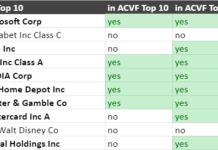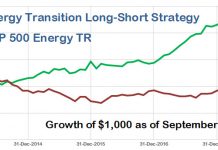UPDATE 3/4/2011: An up-to-date article on selecting green mutual funds and ETFs can be found here.
A Choice of Alternatives
There are now 6 mutual funds focused on what I usually refer to as "Clean Energy." I use this designation because "Renewable Energy" does not include Energy Efficiency, which is the most cost effective and scalable way of cleaning up the economy, while "Alternative Energy" usually is taken to include such technologies as nuclear and coal-to-liquids.
Nuclear may have low carbon emissions, but security concerns, waste disposal, and cost all lead many investors who wish to green up their portfolios reluctant to invest. Coal-to-Liquids companies such as Rentech (RTK), in contrast, emit as much or more carbon than would be emitted by the use of the same amount of conventional petroleum products. As a strategy to cope with peak oil, coal to liquids only makes sense if you ignore the climate impact, and hence these companies cannot be considered clean, even if they are alternative.
The six mutual funds which mostly focus on such clean energy technologies (as opposed to the broader categories of Cleantech or Socially Responsible/SRI) are the American Trust Energy Alternatives Fund (ATEAX), the Calvert Global Alternative Energy Fund (CGAEX), Firsthand Alternative Energy (ALTEX), Guinness Atkinson Alternative Energy Fund (GAAEX), New Alternatives Fund (NALFX), and Winslow Green Growth Fund (WGGFX). In general, all of these have relatively high expense ratios, even for actively managed mutual funds, but if you are uncomfortable trading the Clean Energy ETFs or individual stocks, these are your choices.
A Renewable Mutual Fund in Your 401(k) Plan?
Another reason to use a mutual fund rather than an Exchange Traded Fund (ETF) is if you’re investing through a 401(k) plan. Although most 401(k) plans do not offer a Renewable Energy Fund as an option, there is a movement to encourage companies to add them with a Federal tax credit. There’s also a how-to guide both for individuals trying to encourage their companies to add such funds, and for companies which want to include such funds in their plan.
If your company is planning to add such a fund, it makes sense to add the one which will bring the best diversification at the lowest cost, and that’s what this article is about.
Cost
Many fund advisors will say that their expense ratios are high because the funds are still small. In some part, that is true, but the fees are also high because there simply is not enough competition, and most people investing in one of these funds spend more time thinking about the environment than about what they’re paying to protect it. In my view, it’s important to protect the environment, and worth spending a great deal of money on, but that money should be spent wisely, in order that it be used to greatest effect.
There are two types of fees you will encounter: Front-end loads and ongoing expenses.

Load Funds
A Front-end load is the percentage of your money which you pay to get into the fund, under the rationale that this allows the fund to charge lower ongoing expenses. If you are only considering mutual funds, and are confident that you will leave your money in the fund for many years, then a load fund may make financial sense.
The funds with Front-end loads are the Calvert Global Alternative Energy Fund (class A), and the New Alternatives Fund. Both have front- end loads of up to 4.75%, after which the Calvert fund’s expense ratio is 1.85%, and the New Alternatives fund’s expense ratio is 0.95%, making New Alternatives the far better choice of the two. Most of these funds also have fee for early withdrawal, or back end load, but only if money is not kept in the fund for a minimum period, usually 6 months or a year.
Front-end loads do fall with the amount invested, and are often waived for institutional investors, such as 401(k) plans. Calvert offers class A shares with no sales load to 401(k) and similar retirement plans, but New Alternatives does not seem to.
No-Load Funds
No-load funds recoup their expenses over time, and this cost is expressed in the expense ratio, which is the percent of assets every year which go to the fund manager for expenses and the manager’s profit. For the no-load funds, here are the expense ratios:
| Fund Name | Expense Ratio Investor/Institutional | Minimum initial investment (Standard/IRA) |
| Firsthand Alternative Energy Fund | 2.10%/- | $2000/$2000 |
| American Trust Energy Alternatives Fund | 1.89%/- | $5000/$2500 |
| Calvert Global Alternative Energy Fund, Class C/ Institutional A | 2.85%/1.85% | $2000/$2000 |
| Guinness Atkinson Alternative Energy Fund | 1.64%/- | $5000/$1000 |
| Winslow Green Growth Fund | 1.31%/1.06% | $2500/$2000 |
Investor shares are those offered to the public, but a 401(k) plan would qualify for the lower expenses available to institutional investors.
In this fee comparison, the Winslow Green Growth Fund wins out, since it not only has one of the lower minimum investments, but also has the lowest expense ratio. The Winslow fund also compares favorably to the New Alternatives fund, since it would take about 9 years for the lower expense ration of the New Alternatives fund to pay back the cost of the front- end load.
Holdings
The other factors to consider are the funds’ holdings. Do they invest globally? Are they overly concentrated on particular sectors, such as solar? How much of their
money is invested in clean energy?
Unlike some of the ETFs, all of these funds invest globally. However, reading the fund descriptions, you will find that the Winslow fund is focused on "environmentally responsible" companies, while New Alternatives "It usually invests at least 25% of assets in common shares of companies which have an interest in alternative energy." In contrast, the other funds are all at least 80% committed to alternative energy.
Those are just the investment guidelines, however. More important is how the funds are actually invested. I looked at the top ten holdings of each, and here is my categorization of their holdings, and here is the breakdown over major clean energy categories. I combined technologies such as wave power, batteries, and geothermal into the "Other clean energy" category because of the small amounts held. With diversified renewable energy companies, I split the ownership between the various categories based on my judgment of how much of the company was involved in each business.
Top ten holdings can change any time, but this should at least be an indication of the general thrust of each fund’s strategy.
On the assumption that investors are not buying these funds because they want a fund that is very much focused on clean energy, a fund’s investments in the "Utility" and "Non-energy" categories are mostly wasted. The utility companies in these funds are the greener electric and gas utilities, but they still derive the majority of their energy from fossil fuels. Additionally, I currently expect regulated utilities to underperform for the next year or two.
In contrast, I think that clean energy investors should strive to emphasize energy efficiency companies in their portfolios. This is for the same reason that we do energy efficiency first before installing renewable energy systems on our house. Energy efficiency measures are much more cost effective. Most energy efficiency measures pay for themselves in just a few years, and that is why energy efficiency features so prominently in the stimulus plan: the economy will get a short term boost from the spending, but there will also be larger long term gains from the energy savings over time.
Also because of economics, I prefer investments in Wind companies to Solar companies, so despite the large investment of the Winslow fund in two medical companies and an internet company, I still think it has the best portfolio of the six, followed closely by the American Trust Energy Alternatives Fund.
My Top Pick
If you can, you are better off buying one of the clean energy ETFs, or even a portfolio of individual clean energy stocks (here are 10 clean energy picks for 2009.) However, it you want a mutual fund for the ease of investment, or you are looking to add one to a retirement plan, the Winslow Green Growth Fund comes out on top with its emphasis on energy efficiency stocks (including these two Geothermal Heat Pump stocks), and its lower expenses.
Here’s how to invest in the Winslow Green Growth Fund. Don’t forget to read the prospectus.
Tom Konrad, Ph.D.
DISCLOSURE: The Guinness Atkinson Alternative Energy Fund is an advertiser on the author’s website, AltEnergyStocks.com.
DISCLAIMER: The information and trades provided here are for informational purposes only and are not a solicitation to buy or sell any of these securities. Investing involves substantial risk and you should evaluate your own risk levels before you make any investment. Past results are not an indication of future performance. Please take the time to read the full disclaimer here.









Coal will provide the answer to our short-term and intermediate energy needs. It’s plentiful, it’s cheaper than other available alternatives, and a big percentage of the world’s power plants burn it.
TK note: this comment was initially posted by a commenter who called himself “clean coal power” and tried to link to a website. I removed the “clean” part for improved truth in advertising.
Unfortunately, like many other references to Rentech’s technology, it is automatically assumed that Coal-to-Liquid is bad for the environment. I would encourage you to read the press release noted, and read the report referenced in it to get a better idea of Rentech’s actual environmental impact. Their plans include developing only plants that use carbon capture technology and biomass co-feedstock. To simply lump them with all other Coal-to-Liquid technologies that do not take advantage of these means to reduce the environmental impact of the process is misleading.
Brian,
I’m glad to hear the Rentech is working on capturing the CO2. The linked press release says Rentech plans to capture CO2 and sell it of use in Enhanced Oil Recovery…. meaning that more oil will be produced because of the CO2 captured. Such studies never count the CO2 emitted when the new oil is used as part of the carbon footprint, making it appear cleaner.
And that’s only if everything works as expected. It sounds like it probably will, but plans are changed all the time.
Rentech’s fuel may or may not be cleaner than fuel made from petroleum, but a narrowly-defined small carbon footprint alone will not make it clean. From the evidence in the press release you sent, it sounds to me like it’s about on par with petroleum based fuels.
Ontario Green Energy Act: What Can Alt Energy Legislation Do for Investors?
Charles Morand ( AltEnergyStocks ) submits: Dedicated legislation has been at the core of some of the
I bought a lot of GAAEX in 2008. Besides it being by far the worst investment I’ve ever made (more a sector problem than theirs) I’ve come to wonder how owning shares benefits the underlying green tech companies or green tech in general. It seems to me I’m not investing in the companies, but rather speculating on the side by buying and selling shares. Am I wrong? This is a basic investment question, but I must admit I don’t know the answer.
IB-
When you invest in a company, either directly or though a mutual fund, you are increasing the company’s stock price, because yo are one more buyer in the market. A hicher stock price helps companies in several ways.
1) When they want to raise funds by issuing stock, they can do so witout giving up as much control of the company.
2) Incentives to employees in the form of stock and options are more valuable, leading to a more loyal an motivated workforce.
3) The company will be less likely to be taken over by other companies, which means they are more likely to continue pursuing the business strategies you approve of.
4) A higher stock price makes it easier for a company to issue debt, because the Debt/Equity ratio that many lenders look at will be better.
5) New startups in the same industry will also benefit because when venture capitalists are trying to value them, they often look to publically listed companies in the same industry to see what price the startup would fetch in an IPO.
Broadly speaking, there are two key aspects of alternative energy adoption. The most obvious is technological, and much effort has been spent not only making the technology more economical, but in choosing the right solution for any given situation. The other broad aspect of alternative energy adoption is economic, and involves providing incentives for change before other factors force it. Many economic measures are being adopted to spur these changes, of which alternative energy mutual funds are but one.
The company will be less likely to be taken over by other companies, which means they are more likely to continue pursuing the business strategies you approve of.
Alpha is a measure of the difference between a funds actual returns and its expected return given its risk level as measured by beta. A positive figure indicates that the alpha, the fund has done better than its beta predicted. By contrast, a negative alpha indicates poor performance of the fund, taking into account the expectations created by the funds beta.
Any investment, including one in a mutual fund renewable energy, should include the risks that are acceptable to the investor. Risk levels are established for a reason, as are the strategies and objectives and go beyond the limits of risk can be a big mistake. Regardless of how good advice may seem, or the force of an intuition that the investor may think that research should provide the basis necessary to buy or sell mutual fund alternative energy.